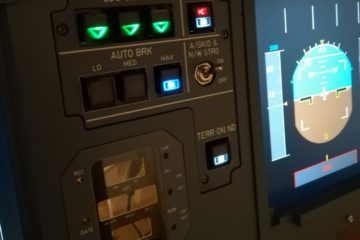Now that you’ve got a feel for the characteristics of your home cockpit project, it’s time to pay attention to the software you’re going to need. The target of this strategy is, that you will be able to practise flying while you’re simultaneously building up your home cockpit.
After reading this article you will be in a position to decide, which Flight Simulation and Flight Management Software fits best for you. So let’s get started!
To make your home cockpit come alive, you need at least two kinds of software:
A. The Flight Simulation Software, which provides the aerodynamic model and the visual system
B. The Flight Management System, which represents the aircrafts system logic
I will now show you which common software products are available of each type and I will give you a personal recommendation at the end of the respective section.
Flight Simulation Software
1. Microsoft Flight Simulator
The most famos product of this category is still Microsoft© Flight Simulator. The latest version (published 2006) is Flight Simulator X (abbreviated FSX). Although the development of this product was discontinued after Version X, in simulation communities it is still in common use because of its wide distribution and the availability of lots of add-ons. Technically FSX doesn’t provide enormous graphics experiences, but therefore it works a bit better with older and less powerful hardware, which can be an advantage, if your budget is very small.
2. Lockheed Martin Prepar3D
In 2010 Lockheed Martin launched its product Prepar3D (abbreviated P3D). Prepar3D is based on Microsoft FSX, but has been developed further significantly. For example, P3D became 64 bit capable with version V4. Now what does that mean? Through its 64 bit architecture, the software is able to allocate more than three gigabytes of main memory. This fact is very important in flight simulations, especially when you are using lots of add-ons, like nearly every simulation enthusiast does. Or when you’re simulating long haul flights. Furthermore, P3D consists about many other improvements like the use of Microsoft© DirectX 11 and current graphics standards. Therefore, it takes a higher advantage of the performance of your graphics card, but it also puts much more load onto it, what requires a pretty powerful current graphics card. The development of P3D is still ongoing, so more features and improvements may be provided in the future.
3. X-Plane
X-Plane is developed by the company Laminar Research (USA) and differentiates itself from other simulators by an alternative aerodynamic model which makes the flight experience more realistic. X-Plane comes out of the box with high quality sceneries and seems to run more stable than other simulators. Furthermore it has also got a 64 bit architecture and is still in further development. Unfortunately, it isn’t running with Jeehell FMGS and the customization possibilities through add-ons aren’t comparable to other simulators. So it is’nt really an option for airbus builders. You should be aware that X-Plane home cockpits are rather rarely found and require a higher effort on setup and management in total.
Which Flight Simulation Software should I choose?
No matter which product you choose: Please make sure you do not underestimate the consequences of this small decision. Once you have started to build up your home cockpit, there will occur a lot of dependencies. You will quickly start to setup your system, install add-ons for airports and scenery and begin to interface your hardware with specific software. The bigger your home cockpit grows, the harder and much more effortful it will be, to switch over to another Flight Simulation Software, even if most of the current add-on software is compatible to both products by now.
My personal recommendation is: If you’re kicking off your home cockpit project right by today, I would recommend to set it up on Prepar3D because of two reasons:
- Because of its hardware support features like the 64 bit architecture and the use
of current graphic standards like DirectX 11 - It’s future-proof, because it’s still in further development
Flight Management System Software
This part is highly interesting – with this software, your home cockpit instruments and displays will first come to life!
As I am building an Airbus A320 home cockpit, my experience focusses on the Airbus A320 Flight Management and Guidance System (short: FMGS). This software replicates the electronic instruments like the Primary Flight Display (PFD), the Navigation Display (ND), the onboard computer (MCDU), the Flight Control Unit (FCU) and more.
Please note: This software is not just download, install and play! You first have to learn and basically understand, how to start up an A320 and how its systems work, until you will successfully take off for the first time. I will guide you through the very first steps in future blog post, but please – take your time, a good cup of coffee and read the manual in detail.
Which common Software Products are available?
1. Jeehell FMGS
Jeehell FMGS is developed and supported by Jean Luc Nitard from Nice, France. The software is freeware. The Logo’s Link points to Ben’s SoarbyWire.com Blog, who brought the support information to the point.
2. ProSim A320 or ProSim 737
ProSim A320 and ProSim 737 are developed and supported by ProSim Aviation Research B.V. in the Netherlands. The software is chargeable. Link to ProSim Shop with prices.
Which Flight Management System Software should I choose?
When you are building an Airbus A320, it is obvious to use Jeehell FMGS because of the big difference in costs. The software is a great piece of work and it’s still in further development. ProSim A320 consists about mostly the same graphical layout and system functions as Jeehell FMGS. As far as I know, nearly all boeing builders commonly use ProSim 737 for their home cockpit project.
Feel free to comment below about your Experiences with FMGS-Software!








4 Comments
Dominik Fasura · August 13, 2020 at 10:54 am
Hi,
I found your website and I’m fascinated. I have read your entire website thoroughly. But I have a few questions that you can answer me about the software. I have no problem with the hardware. I have experience with electrical engineering and even wood processing. But software is my weakness. Can you explain to me more precisely the advantages and disadvantages of each flight simulation software and Flight Management System Software. You convinced me that it is probably not worth building a home cockpit for X-PLANE 11, but what software to choose to cover as many functions that can be done or influenced in the cockpit and what software to choose for connecting hardware and flight simulator. I mean maybe the buttons in the overhead panel. Right in X-PLANE 11 at paid ware on airbus a320 by FlightFactor, some buttons cannot be launched. And I want to make a home cockpit with as many active options as possible. I really appreciate your work and that you share your experience. I hope you can help me.
Marco · August 13, 2020 at 11:20 am
Hi Dominik, first of all, thank you very much for your positive feedback, I appreciate that a lot! To be honest, the questions you are asking for are hard to be answered in general. Regarding the flight simulation software: In the meantime we have Microsoft Flight Simulator 2020 in the pipeline that will surely become the new first choice in simulation software. So my recommendation is to wait until FMGS developers have fit their solutions so they work with FS 2020. This will surely take 6 months, maybe longer.
Regarding the connection software for components: This depends a lot on your approach on flight simulation. If you are infected by OEM hardware like me, you’ll need a different kind of interfacing hard- and software. Otherwise there are a lot of companies that offer Plug & Play simulation hardware, that works very fine and consist of a very high system depth. e.g. Skalarki Electronics. As I said, not easy to answer. A way can be, to start up small and grow from one system to another, like I did. If you say software is your weakness, you might prefer to go with Plug & Play hardware (more expensive than selfmade, but stressless) Another approach can be to give Arduino a try – start up with small interfacing projects. Install a cheap fligh simulator with Microsoft FSX and Jeehell FMGS and experiment a little bit with a button or a switch. This has low costs and you can find out if this is your way. I should definitely write a post on this topic, I see 🙂 For further questions, don’t hesitate to contact me!
Dominik · August 13, 2020 at 11:37 am
Hi Marco,
Thank you for the quick reply. May I ask what combination of Flight Simulation Software and Flight Management System Software you chose for your home cockpit? I will definitely wait for the release of Microsoft Flight Simulator 2020, it will definitely take me more than 6 months to build the cockpit, so I have nowhere to hurry: D And I would still like to know if FMGS is compatible with arduino? And whether the LED indicators can be set in FMGS, as it works in SimProA320.
Dominik · August 13, 2020 at 12:33 pm
Thanks for the clarification. I will try to connect FSX and Jeehell FMGS. I see you are currently using Jeehell FMGS and you are flying in FSX or Prepar3D?
Plug and play cockpit products are out of the question for me, they are expensive and you are right that I would be stressless.